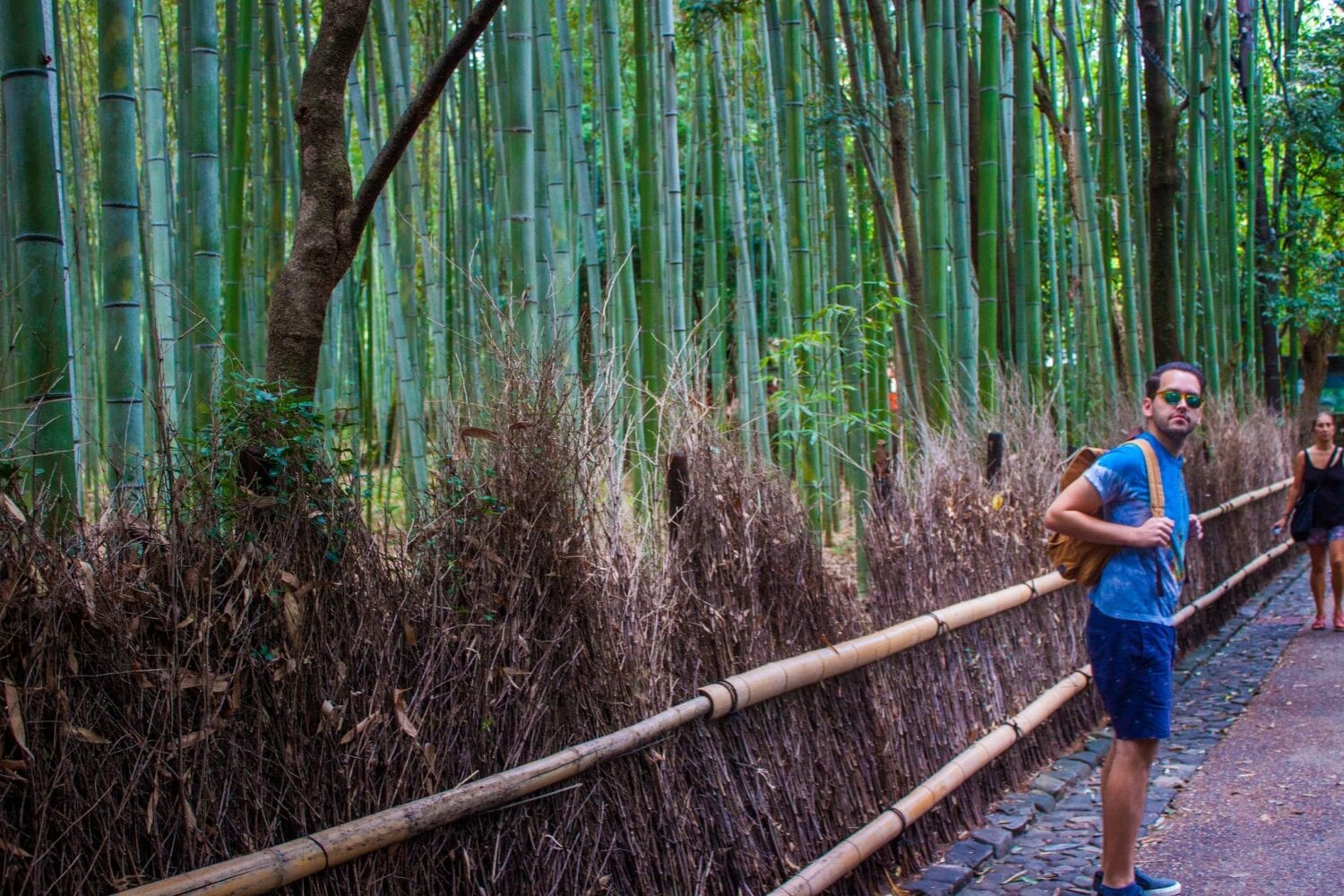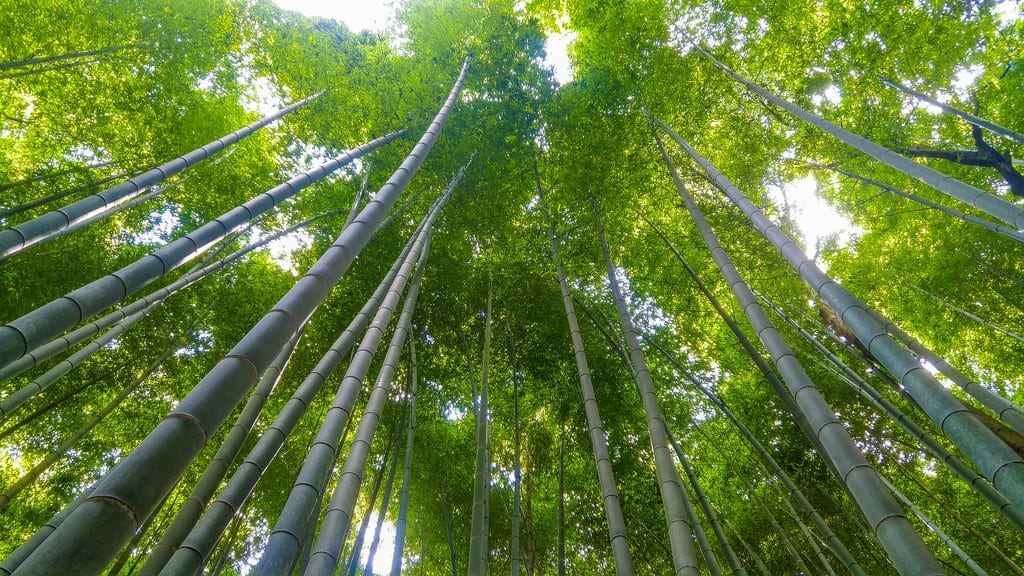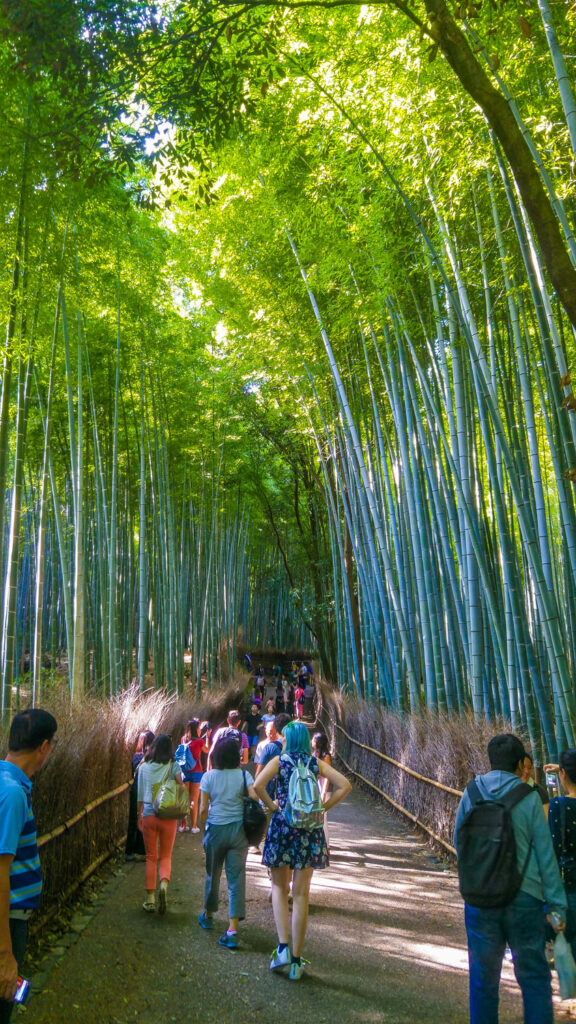

The first morning in Kyoto we decided to venture outside the city and visit one of Kyoto’s most popular sights: the Arashiyama Bamboo Grove. Heralded as being one of the “most beautiful groves on earth” and designated a “National Historic Site and Place of Scenic Beauty” by Japan, the Arashiyama Bamboo Grove is a place unlike anywhere else. It’s a place where you can escape yourself, as long as you manage to escape the throngs of tourists as well.




We set off to Arashiyama by bus. There are multiple ways of getting to the Grove, and most people will opt for the train option since you avoid the chance of getting into any traffic jams, but the bus route for us was much faster from our destination, so always be sure to check before departing to see which route will be the fastest from your location. The bus does have a bonus aspect of seeing Kyoto and the surrounding countryside as you drive.
We took the #73 bus from outside Higashihonganji Temple. It cost just 230 yen for the entire journey. Remember on the buses in Kyoto you pay your far after you exit the bus, not when you get on. To get there by rail, you simply take a train from Kyoto Station and take the JR Sagano/San-in Main Line to Saga-Arashiyama Station. The ride takes 15 minutes followed by a 10-minute walk to the Bamboo Grove. The ride costs 240 yen.
As you approach Arashiyama, the first thing you’ll see is that the flat vistas disappear for mountainous ranges. In the early 700-1100s, wealthy nobles would travel to Arashiyama to enjoy its natural landscape and escape the city. While it’s still true that people come here as an escape, now this place is for everyone, rich or poor. The word “Arashiyama” translates into “Storm Mountain”. The mountains here are covered in lush trees, and because of this, they are slightly dark, giving them their intimidating name. The mountains look down on the Ōi River, creating a picturesque view as you drive in.
Arriving in Arashiyama, you get off the bus and walk up the main street to enter the forest. Entering the forest by bus also gives you access to the less used entrance, and you’ll notice that there are much fewer people here than where the train station drops people off. The streets of Arashiyama in the early morning are relatively quiet. The main street of Arashiyama is quite touristy, so early in the morning not many people are out walking the streets. Arriving as early as you can is the best way to view both the city and the forest before it is overrun with sightseers.
Even the manhole covers here in Arashiyama reflect the natural surroundings.
The Bamboo Grove, take up over 500 meters of winding pathways. To get to the start of the path, head west from the train station. There are dozens of signs in English and Japanese to help guide your way. The entrance to the beginning of the bamboo grove is flanked on either side by thick concrete walls and it’s strange to this that this narrow, cold passageway will open up into a spectacular oasis. The grove is never closed and there is (currently) no admission to enter. But like Venice, who city council is now charging admission to enter it’s ever growing popular city center, this could change over time to help preserve the forest.
Obviously everyone wants to be here when you’ll have a clear shot of the grove without anyone in the way. And while there are those precious few rare moments they’re very hard to find. Lots of people will tell you to come even before sunrise. And while that’s probably your best chance, even those super early risers have been disappointed to see that hundreds of other had the same idea.
My advice is to take the crowds as they come and not to stress about waking up SUPER early on what’s supposed to be a relaxing vacation. I actually found that later in the afternoon there were the least amount of people in comparison to the morning. It seemed like the tour buses were well on their way home as the sun began to set. But even with tourists aplenty there is still plenty to enjoy and ways to get those amazing shots!
If one area becomes inundated with people, quickly pass through the crowd, and suddenly you’ll see that the path opens up. The dense areas of individuals tend to be formed by bus tours, all walking through together, so if you pass by them quickly, you might find that space they just left is pretty empty. A lot of these tour buses also don’t spend too much time in the forest. They enter at the beginning of the path but never make it to the end. I found that if you walk to the very end of the grove you’ll find that by the end of the path, you’ll have the place to yourself at times.
As you first walk into the forest, you’ll be immediately struck with the overwhelming quiet that the grove creates. You are enveloped by these towering emerald stalks, so tall they almost stop light from entering in. The bamboo itself is truly stunning. The stalks are so thick and bright green in the sunlight. The trunks creak ever so much when a big gust of wind passes through, and they make the eeriest, yet wonderfully delicate, noise. Like a old, worn floor when you walk across it in the night.
While the Bamboo Forest is not only gorgeous to look at their importance to Japan spreads farther than just a pretty picture. Bamboo is one of the strongest plants there is. Standing up, so straight and tall, one wonders how that’s scientifically possible, They sway and bend in the wind and yet almost never crack. In fact, historically people would run into the bamboo groves when there was an earthquake since the root structure of the bamboo was so strong it would even withstand such a powerful force as an earthquake.
One of the most popular uses of this strong material was in building roads and in the construction of houses. You’ll still see many construction sites in Japan using bamboo as scaffolding to this day since it is so strong. Bamboo is used to ward off evil and people also write their wishes on strips of paper made from bamboo during large Japanese festivals. It’s used to create wind instruments and handicrafts. It’s also used as an important ingredients in many Japanese and international dishes as well as for many herbal remedies. There are so many things which incorporated bamboo within the daily life of a person in Japan and it’s important to keep this in mind when exploring the forest.
Different parts of the path veer off giving access to the various other attractions that are housed inside the forest. The Tenryuji temple and Nonomiya Shrine serve as markers which flank either end of the path. Inside the bamboo grove, you’ll stumble upon the Nonomiya Shrine. This little Shinto shrine is where unmarried imperial princesses have journeyed to purify themselves before their marriage. The deities that are enshrined here include “Nonomiya Okami”; God of Health and Wisdom, “Shirafuku Inari Daimmyojin”; God of Conception, Smooth Childbirth, and Prosperous Business, “Shiramine Benzaiten” and most importantly for single women, “Nonomiya Daikokuten”; God for Matchmaking.
Good luck talismans are sold near the shrine to give good fortunes to the receivers. Their colourful embroidery is so striking and makes even the happiest person feel in “need” of a good luck charm.
Many couples make their way here to pray for a good marriage with their partners. We were sure to stop momentarily to ring the bell, clap our hands, and bow to the shrine. A little more luck can’t even hurt 🙂
This shrine is also a place where married couples wish for a healthy baby and painless childbirth. So you’ll often happy couples holding hands or pregnant women writing their wishes on the ema boards near the front of the temple.
Beside the temple, there is a cemetery with hundreds of obelisk stones standing guard beside the gate. Each one represents either a person or an entire family, who are entombed below. Since it is law in Japan that a person is cremated after death, whole families are often buried together. Their living relatives will often come to visit their graves and place offerings when they do. These offerings are often things the people enjoyed in their waking life. You’ll see things like books, beers and even dishes of food laid out on top of the stones. It’s a wonderful tradition that makes it feel like those people are still with us. Coming out at night to dine, read or drink in the moonlight.
At the end of the woods, you’ll come across the Sagano Scenic Railway, which has also been dubbed “the Romantic Train”. It’s a retro-style steam train which runs along the Hozu River, giving viewers some fantastic views of Arashiyama as it chugs along. The station itself is stunning and makes you feel like you’ve stepped back in time.
Throughout the maze of bamboo, artisans pop up around every corner, selling various crafts made out of the pliable substance. They shape the bamboo into birds and animals with the most delicate touch.
Bicycle rentals around the grove are available is you want to cruise through the grove as well as explore the other areas around the forest. Bicycle rentals will cost you around 500-1500 yen per day depending on where you pick up your rental. There are also many rickshaws which will carry you and one other person through the pathways. These tend to be pretty expensive with prices ranging from 5,000 to 7,000 yen for a 20 mins ride for two people.
These will not only take you through the forest but the surrounding village as well. It’s comparable to prices of gondolas in Venice. Personally I think it’s much more enjoyable to watch these rickshaws run by than ride inside them but that simply because I’d prefer to save that money for a delicious meal. I found the best way to explore was by foot. Take your time. Listen to the wind blowing through the bamboos and soak up as much of the tranquility as you can.
To escape some of the busier moment in the forest I recommend heading over to the Okochi-Sanso Villa or the Tenryuji temple. Both of these places charge a small admission to enter but by charging a small amount to explore this both reduces and controls the traffic as well as helps preserve the environment.
Something for Arashiyama to consider for the Bamboo Forest itself is a small entry fee to enter the grove. This is something Venice is also implementing to help preserve their historical city center against day trippers who come in and don’t spend any money in the town itself. Arashiyama has a similar problem with bus tours who simply arrive at the forest, drop the tourists off, allow them a short time to explore the forest. Then, they pile them back on the bus without giving them anytime to explore the town and spend some money their to help the villagers support their hometown. I implore you if you are visiting the grove to make a time to explore the entirety of Arashiyama Village.
The bamboo forest is truly one of the most incredible nature wonders of the world and a MUST for anyone visiting Japan. Don’t miss out. Don’t get caught up with the crowds. Come with realistic expectations of how many other people want to see this incredible place. You most likely won’t have it all to yourself but how can you blame other for also wanting to see this wonder? Finding peace within this chaos isn’t something that comes easy, but when you do find it, that’s what makes the journey worth it.
Perched dramatically on a limestone hill overlooking the lush Tipperary countryside, the Rock of Cashel…
Affectionately known as the "Garden of Ireland," Wicklow County is one of the most breathtaking…
Paris has long been a magnet for writers for hundreds of years, with iconic figures…
Paris transforms into a magical wonderland from November to January, bursting with festive charm and…
French cuisine is one of the coziest delights to savour in winter. With its hearty…
During the festive season, Paris becomes a sparkling holiday dream, with twinkling fairy lights cascading…
This website uses cookies.